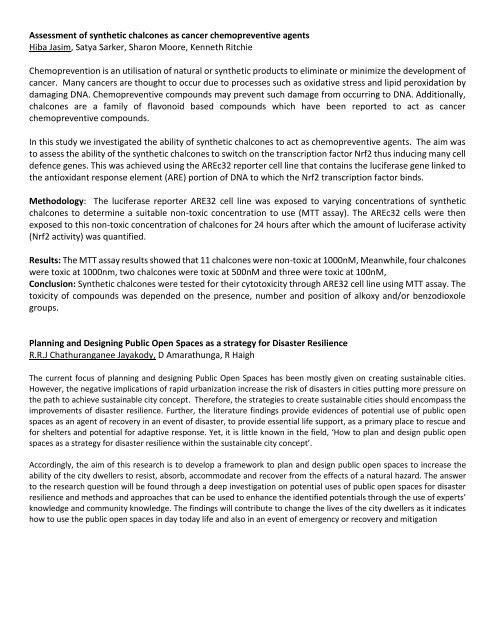Conference Programme FULL (1)
Create successful ePaper yourself
Turn your PDF publications into a flip-book with our unique Google optimized e-Paper software.
Assessment of synthetic chalcones as cancer chemopreventive agents<br />
Hiba Jasim, Satya Sarker, Sharon Moore, Kenneth Ritchie<br />
Chemoprevention is an utilisation of natural or synthetic products to eliminate or minimize the development of<br />
cancer. Many cancers are thought to occur due to processes such as oxidative stress and lipid peroxidation by<br />
damaging DNA. Chemopreventive compounds may prevent such damage from occurring to DNA. Additionally,<br />
chalcones are a family of flavonoid based compounds which have been reported to act as cancer<br />
chemopreventive compounds.<br />
In this study we investigated the ability of synthetic chalcones to act as chemopreventive agents. The aim was<br />
to assess the ability of the synthetic chalcones to switch on the transcription factor Nrf2 thus inducing many cell<br />
defence genes. This was achieved using the AREc32 reporter cell line that contains the luciferase gene linked to<br />
the antioxidant response element (ARE) portion of DNA to which the Nrf2 transcription factor binds.<br />
Methodology: The luciferase reporter ARE32 cell line was exposed to varying concentrations of synthetic<br />
chalcones to determine a suitable non-toxic concentration to use (MTT assay). The AREc32 cells were then<br />
exposed to this non-toxic concentration of chalcones for 24 hours after which the amount of luciferase activity<br />
(Nrf2 activity) was quantified.<br />
Results: The MTT assay results showed that 11 chalcones were non-toxic at 1000nM, Meanwhile, four chalcones<br />
were toxic at 1000nm, two chalcones were toxic at 500nM and three were toxic at 100nM,<br />
Conclusion: Synthetic chalcones were tested for their cytotoxicity through ARE32 cell line using MTT assay. The<br />
toxicity of compounds was depended on the presence, number and position of alkoxy and/or benzodioxole<br />
groups.<br />
Planning and Designing Public Open Spaces as a strategy for Disaster Resilience<br />
R.R.J Chathuranganee Jayakody, D Amarathunga, R Haigh<br />
The current focus of planning and designing Public Open Spaces has been mostly given on creating sustainable cities.<br />
However, the negative implications of rapid urbanization increase the risk of disasters in cities putting more pressure on<br />
the path to achieve sustainable city concept. Therefore, the strategies to create sustainable cities should encompass the<br />
improvements of disaster resilience. Further, the literature findings provide evidences of potential use of public open<br />
spaces as an agent of recovery in an event of disaster, to provide essential life support, as a primary place to rescue and<br />
for shelters and potential for adaptive response. Yet, it is little known in the field, ‘How to plan and design public open<br />
spaces as a strategy for disaster resilience within the sustainable city concept’.<br />
Accordingly, the aim of this research is to develop a framework to plan and design public open spaces to increase the<br />
ability of the city dwellers to resist, absorb, accommodate and recover from the effects of a natural hazard. The answer<br />
to the research question will be found through a deep investigation on potential uses of public open spaces for disaster<br />
resilience and methods and approaches that can be used to enhance the identified potentials through the use of experts’<br />
knowledge and community knowledge. The findings will contribute to change the lives of the city dwellers as it indicates<br />
how to use the public open spaces in day today life and also in an event of emergency or recovery and mitigation


